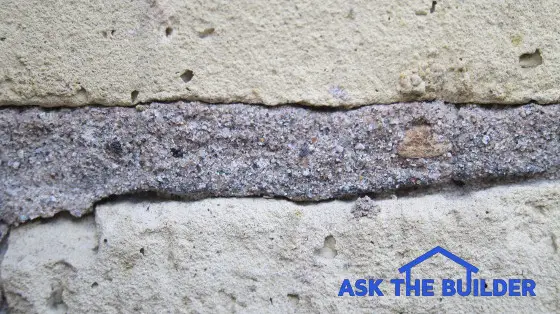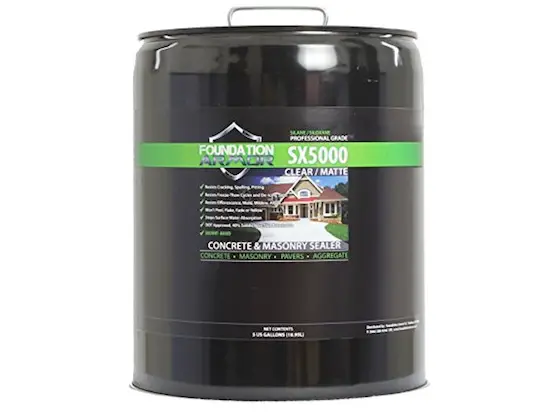Why Seal Brick and Mortar? Simple – Brick Veneer LEAKS

Seal Brick and Mortar | This is a closeup photo of a mortar joint between two layers of brick. Note the tiny cracks where wind-driven water can seep into the wall. (C) Copyright 2018 Tim Carter
DEAR TIM: My brick home and virtually every other brick house in my sub-division leak water when it rains. This water is causing mold growth in our exterior walls. I thought brick walls were supposed to be weatherproof, that is why I specified them. What is wrong? Can the brick be sealed? Does the brick job have to be re-done? Is there a less-expensive alternative? Doug C., Mason, OH
DEAR DOUG: I can't begin to tell you how downcast my mood becomes when I get letters such as yours. In my opinion, there are quite possibly hundreds of thousands of brick veneer homes built in the past 15 or 20 years that are ticking time bombs. Many brick masons and builders do not follow simple and long-established industry standards that would otherwise allow them to construct brick walls that can keep you and your home dry and mold-free.
Do bricks leak during rainstorms?
Yes, brick walls leak during rainstorms. Most of the water enters the wall through tiny cracks in the vertical mortar joints between two brick.
Believe it or not, even the most talented brick masons using the highest level of skill and materials cannot build a brick veneer wall that will stop water infiltration. Brick walls leak water and some leak vast amounts of water during a wind-driven rainstorm. Well over 50 percent of the USA experiences wind pressures of 25 pounds per square foot or greater. Add to this the pounding effect of tens of thousands of raindrops on the side of a brick wall and you have a recipe for disaster.
But that being said by no means lets bricklayers and builders off the hook. The industry has known for years that brick walls leak water and lots of it. The trick is to build a system that:
- protects the wood framing of the house from getting wet
- collects all water that leaks through the walls
- re-directs all of the collected water back to the exterior as quickly as possible
The most troubling thing is that it is very simple to build a brick veneer house that performs exactly as you thought it should. It adds very little extra cost to do so as the house is being constructed.
How do you keep wood framing dry?
Flashings and waterproof membranes help keep wood framing dry.
The builder and bricklayer must work together to install top quality flashings on top of the foundation wall where the first course of brick begins. All inside and outside corners as well as overlap joints must be sealed perfectly. The same flashing material is used where brick passes over the top and under the bottom of all doors and widows. The house framing must be covered with a water membrane such as tar paper or modern water-infiltration barriers. Weep holes that let accumulated water out from behind the brick should be placed on two-foot centers. Special synthetic fabric should be placed behind the first courses of brick. This fabric keeps mortar droppings from clogging the weep holes.
What would it cost to re-install the brick on my home?
But all of this means little to you now unless you decide to remove your existing brick veneer and start over. That is an enormously expensive proposition. I would not be shocked if you received a price of $2.50 PER brick to do such a job. The average house can easily have over 18,000 brick! The cost will be even higher as other exterior building components will undoubtedly be harmed by the processes of demolition and the reinstallation of the brick.
Is there a brick sealer?
The first thing to try is a solvent-based clear silane siloxane masonry sealer. The one below is a great one because it's NOT water-based. Solvent-based sealers penetrate deeper into brick and mortar.
What's the best way to apply brick and mortar sealer?
It's best to have two people apply the sealer. One person is wearing a powerful backpack leaf blower. As the other person sprayes the wall, the person with the blower BLASTS the wall with air to drive the sealer deep into the masonry. The deeper the sealer penetrates, the better protection you'll have.
Be sure to apply MULTIPLE coats of the sealer within minutes of each other. Read the instructions on the label of the product. Once the first coat dries, it will BLOCK the second coat from penetrating into the brick or mortar. You MUST WORK FAST.

This is a magnificent silane - siloxane water repellent that soaks into brick and mortar. CLICK or TAP HERE or THIS IMAGE NOW TO ORDER IT.
Is there another brick sealer product?
There used to be another product, but I'm no longer sure if it's made and I'm now skeptical of the company that used to make it.
But before you begin to demolish your brick walls, I urge you to try an inexpensive yet revolutionary product that appears to be able to absolve the sins of the negligent builders and brick masons. You can purchase via the Internet an elastomeric joint sealant that brushes on the mortar joints in brick, block and stone walls. These are the places where the water gets into the masonry surfaces. The sealant can actually bridge cracks up to one eighth of an inch. It works best if you apply a water based silane / siloxane water repellent just before applying the water based joint sealant.
I applied some of this sealant to my brick chimney. It is very easy to apply. The product is white and has the consistency of vinyl wallpaper paste. But when applied per directions, it dries nearly crystal clear. You can only see something has been applied to the brick wall if you stand close and look at it. If you were to look at my chimney from the street, there is no way you could tell I did anything to it. I urge you to try this product as soon as possible. You must stop the water infiltration immediately if you desire to stop further mold growth.
4 Responses to Why Seal Brick and Mortar? Simple – Brick Veneer LEAKS